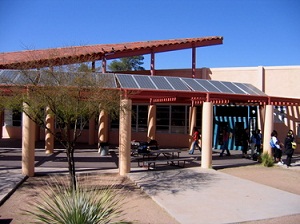Tucson utility to lease school rooftops for grid-tied solar
 Plenty of schools and school districts across the country are adding solar to their roofs under long-term power-purchase agreements (PPAs). But Tucson Electric Power’s (TEP’s) new Bright Roofs program would lease the space from school roofs to provide solar power to the grid, not the schools.
Plenty of schools and school districts across the country are adding solar to their roofs under long-term power-purchase agreements (PPAs). But Tucson Electric Power’s (TEP’s) new Bright Roofs program would lease the space from school roofs to provide solar power to the grid, not the schools.
The company, a subsidiary of UniSource Energy (NYSE: UNS), plans to lease school and other public facility rooftops to develop 11 megawatts (MWs) of solar capacity, which TEP would own, over the next three years.
“We saw an opportunity to make use of un-utilized space in our service areas,” said TEP spokesperson Joe Salkowski.
Under the program, schools and public facilities with at least 50,000 square feet of flat rooftop space, enough room for a 250-kilowatt photovoltaic array, are eligible. The utility will use SunPower Corp.’s (Nasdaq: SPWRA, SPWRB) T5 Solar Roof Tile systems, which don’t require rooftop penetration.
At this point TEP hasn’t signed any contracts (the program was announced this week), but some schools have already expressed interest. The Tucson Unified School District is considering putting solar on six of its high schools, according to the Arizona Daily Star.
Generally, it’s easier to find locations for solar arrays on the outskirts of towns and more difficult to find it in developed areas, according to Salkowski.
“This makes it easier to find space and generate lease revenues for them,” he said.
“One of the advantages of this program is that it gives us an opportunity to locate solar within our developed areas. Near where our load is, it can be helpful. We do have need of the larger systems we will be building just as a matter of scale. We need both,” Salkowski said.
The utility, which services the Tucson, Ariz., metro-area and some nearby unincorporated areas, is adding in more solar to meet the requirements of the state’s renewable energy standard, which will require utilities in the state to source 15 percent of their power from renewables by 2025.
The portfolio standard also includes a significant distributed generation carve-out. It requires, by 2012, 30 percent of a utility’s renewable energy to come from distributed sources not owned by the utility, making the Bright Roofs program ineligible under the carve-out. The company has been meeting those carve-outs, according to Salkowski.
Pictured: Doolen MIddle School in Tucson. Image courtesy of Technicians For Sustainability



